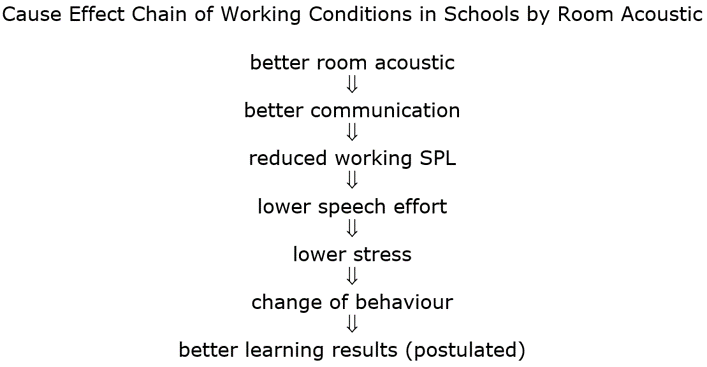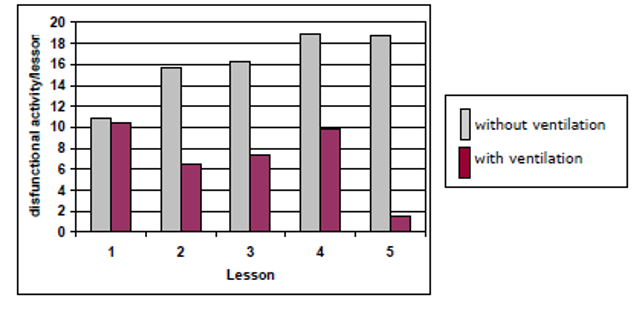
Good classroom design works as a 3rd Pedagogue!
In a post-Covid world this applied study has become even more relevant to ensure sustainable teaching and learning environments.
This research carried out by University of Bremen ISF – Institute for interdisciplinary School Research into the impact of improving ventilation was based on previous studies (Bremen III) by ISF about teacher stress and classroom noise which showed a correlation between increasing noise and the working heart rate and vice versa when noise levels were reduced.
This prompted further investigations (Bremen IV) around other indoor environmental qualities to look into the implications of good classroom acoustics and differing ventilation qualities on student concentration, stress and the activity based sound levels.
Starting point of the study: High CO2 level results in concentration impairment and fatigue.
Thus measurements of the CO2 levels in classrooms was undertaken. Fatigue could be proved using various methods. In addition, concentration tests were carried out with both teachers and students. Further indications of fatigue could be the sound pressure levels in the classroom, or even a change in the teaching methods adopted by teachers as a reaction to the shift in behaviour of the students. Furthermore, the heart rate of the students was monitored as an indicator for fatigue.
How does fatigue manifest itself?
Even before the beginning of the 20th century physicians recognised that fatigue was apparent during classroom tuition. This finding was justified by the obvious reduction in performance of the students. It is commonly understood that high levels of noise and CO2 have a negative effect on students in the classroom.
So, we asked Dr. Gerhart Tielser to explain the impact of ensuring classrooms have good acoustics and air quality as the quality of the indoor environment has never been more important than now to support both teachers and students working comfort and long term health and well being.
“The importance of room arrangement for learning situation was analysed in two research studies: “Acoustic ergonomics of schools” (Bremen III) and “Constitutional influences on lessons at school” (Bremen IV, only in German).” says Gerhart.

Cross-disciplinary approach illustrates the influence about how both acoustics and air quality combine to increase student concentration
Gerhart continued… “Room acoustics is one part of the design of indoor environmental qualities; another one is the quality of the air in the working environment. Research at the end of 19th century by Burgerstein & Netolitzky analysed the influence of CO2 on the attention of people and postulated a critical value of 1000ppm CO2 for good and 1500ppm CO2 for satisfactory learning conditions.”
“Normally in classrooms without mechanical heating, ventilation & air-conditioning (HVAC) nearly 35% of the lesson will have bad air quality (>1500ppm CO2). Research of Bremen IV introduced a 2 min ventilation break every 20 minutes and a 5 min break between the 45 min lessons. These new ventilation breaks resulted in an average increase of 15 minutes for better learning conditions.” added Gerhart.

Gerhart stated simply: “Doing this manual ventilating with the opening of windows every lesson over the whole day resulted in much better student attention to the learning task.”

(nach l.) means with ventilation breaks

- Improving ventilation (Co2) in classrooms with poor acoustics (>0.6s) has only small sound reduction
- Improving ventilation (Co2) in classrooms with good acoustics (<0.6s) has a significant effect with sound reduction

Specific changes in student behaviour we observed…
The study also observed the classroom learning activities and teaching methods adopted by teachers to understand when there were changes in behaviour of the students.

A surprising additional effect was found in the combination of good room acoustics and improved ventilation.
One result of ventilation break is lowering of noise level in the classroom. Sorting the measured sound pressure level (SPL) shows a correlation with the room acoustics, in this case reverberation time (RT). The implementation of ventilation breaks, results in lower sound levels (SPL) both; ambient background noise (SPL) and working or activity noise (SPL). In classrooms with better room acoustics (lower RT) decreasing the working or activity sound levels (SPL) was much better. This combination of good room acoustics with good air quality is more than an addition of both effects, it’s an interdependent positive effect:

Good classroom design can be the 3rd Pedagogue!
More info about the health and performance implications of the school environment which relate to this study are available in a series to download as pdfs below:
1. Importance of CO2 and the characteristics about fatigue – Download pdf here.
2. The different influencing factors and methods used to verify the fatigue of the students during classroom tuition – Download pdf here.
3. Results of the CO2 measurements and the ventilation intervals – Download pdf here.
4. Results of the pedagogic aspects — teaching and learning activities – Download pdf here.
5. Results of the sound pressure level and heart rate measurements – Download pdf here.
6. Summary chain of events, discussion and outlook – Download pdf here.
Read more about the Bremen III in a previous Acoustic Bulletin post here.

Email Dr. Gerhart Tiesler here or visit the German language ISF-Bremen website here.

